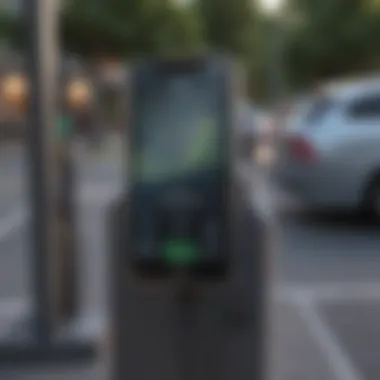Challenges and Limitations of Electric Vehicle Charging


Intro
The shift towards electric vehicles (EVs) represents a significant step in the transition to sustainable transportation. However, this evolution encounters substantial hurdles, particularly concerning charging infrastructure. The effectiveness of EV adoption heavily relies on the accessibility and efficiency of electric vehicle charging stations. Without a reliable charging framework, the potential benefits of reduced carbon emissions could remain unrealized. This section serves to outline the inherent issues surrounding electric vehicle charging stations, which includes technological limitations, infrastructure inadequacies, user accessibility challenges, standardization discrepancies, and economic barriers.
Research Overview
Summary of key findings
The research indicates that several interlinked challenges impede the growth of electric vehicle charging stations. Firstly, inadequate infrastructure is a recurring theme. Many locations lack sufficient charging points to meet rising demand, leading to overcrowding and long wait times. Secondly, there is a technological divide; not all chargers are compatible with every electric vehicle model, which can frustrate users. Thirdly, user accessibility remains a considerable issue, especially for urban dwellers who may lack off-street parking.
Importance of the research in its respective field
Understanding these challenges is crucial for anyone involved in the EV ecosystem. Stakeholders, including policymakers, infrastructure developers, and vehicle manufacturers, can leverage this research to identify specific areas that require attention. By addressing these limitations, we can enhance the user experience and encourage further investment in electric vehicles, contributing to environmental sustainability.
Methodology
Description of the experimental or analytical methods used
This research involved a thorough review of existing literature on electric vehicle charging stations. Surveys were conducted targeting users of electric vehicles to gather firsthand insights into their experiences and frustrations. A combination of qualitative and quantitative methods was applied to ensure a comprehensive understanding of user behavior and preferences.
Sampling criteria and data collection techniques
Participants for the survey were selected based on their usage of electric vehicles for at least six months. This criterion ensured that the feedback received was relevant and informed. Additionally, data was collected through online platforms where EV enthusiasts could share their insights and experiences. Using tools like Reddit and Facebook, the research aimed to gather a wide array of perspectives, maximizing the reliability and diversity of the findings.
"A well-structured charging infrastructure is as essential as the vehicles themselves to ensure a smoother transition to electric mobility."
By synthesizing information from various sources and user experiences, this research aims to offer a clearer picture of the current landscape of EV charging stations, helping to identify key areas that require strategic intervention.
Prologue to Electric Vehicle Charging Stations
The transition to electric vehicles (EVs) represents a significant step toward reducing greenhouse gas emissions and addressing climate change. Central to the efficiency of this movement is the establishment of electric vehicle charging stations. These facilities are not merely logistical conveniences but a fundamental element in supporting the widespread adoption of EVs.
Charging stations facilitate a necessary infrastructure to recharge electric cars, analogous to how traditional gas stations provide fuel. As electric vehicles gain popularity, the importance of reliable and accessible charging points becomes more pronounced. They must be distributed effectively geographically and situated in locations that cater to urban and rural users alike.
There are various types of charging stations, including Level 1 chargers suitable for home use and Level 3 fast chargers that provide a rapid electric boost. Each of these plays a role in making EVs viable for different users. The benefits of a robust charging network include reduced range anxiety, which is a common concern for potential EV owners regarding the distance they can travel.
Moreover, as cities lean toward sustainability, integrating charging stations into existing infrastructure can contribute to a cleaner urban environment. A survey of charging options can also help identify potential gaps within the current network, facilitating targeted enhancements.
Beyond mere placement, considerations such as charging speed, compatibility with various vehicle models, and user accessibility are crucial. Each charge experience affects user satisfaction and can serve as a metric for the overall convenience of owning an electric vehicle.
"The infrastructure for charging is just as critical as the vehicles themselves; both need to evolve together for sustainability to be achieved."
In summary, the role of electric vehicle charging stations extends beyond convenience. They are pivotal in shaping the landscape of electric vehicle adoption, influencing user behavior, and impacting future business models within the transportation sector. Addressing the challenges surrounding these stations is vital to fostering a sustainable electric future.
Infrastructure Challenges
Infrastructure challenges are pivotal to understanding the operational landscape of electric vehicle (EV) charging stations. As more consumers navigate the transition to electric vehicles, the availability and performance of charging stations directly influence the adoption rates and overall success of EV integration into daily life. A robust infrastructure ensures that EV users experience convenience, reliability, and efficiency, contributing to a sustainable future.
Insufficient Charging Point Distribution
One of the primary infrastructure challenges is the insufficient distribution of charging points. Many urban and suburban areas still lack adequate charging stations, creating barriers for potential EV users. This scarcity often leads to long waiting times at the few available stations, discouraging prospective owners from making the switch to electric vehicles.
- Geographic Disparities: Rural areas suffer significantly due to fewer charging options compared to urban centers. This hampers access and creates a false perception that EVs are impractical in less-dense populations.
- Economic Viability: Investment in charging infrastructure may not seem immediately lucrative for stakeholders, further complicating the distribution issue.
- User Inconvenience: A lack of sufficient charging stations can lead to range anxiety, wherein users fear they may not find a charging point when needed, undermining the growing consumer interest in EVs.
Location Limitations


Location is critical when deploying EV charging stations. There are numerous considerations that influence where these stations can and should be located.
- Public Spaces: Charging stations are often placed in public areas such as shopping centers, airports, and public parking facilities. Their proximity to these locations can significantly influence user decisions; however, not all regions have the necessary zoning regulations or physical space available for development.
- Accessibility Issues: Many desired locations may have challenging access features, such as traffic congestion or limited available space, complicating their installation.
- Strategic Placement: For effective distribution, charging points should be placed along major travel routes and in areas with high EV ownership. However, this often clashes with local government regulations and private property rights.
Grid Capacity Issues
The electric grid is fundamental to the operation of EV charging stations. As the demand for electricity increases due to more EVs on the road, grid capacity becomes a pressing concern.
- Capacity Constraints: Older grids may struggle to handle the extra load from charging stations, leading to the risk of outages or reduced performance during peak usage times. This necessitates substantial investment in grid modernization to enhance resilience and capacity.
- Renewable Integration: Integrating renewable energy sources into the grid is crucial for sustainability, yet many areas lack the infrastructure to support this transition effectively.
- Future Demand: As EV adoption grows, it is essential to consider future grid expansions to ensure that charging stations can operate efficiently without compromising service quality for existing power needs.
"A comprehensive approach to improving charging infrastructure must involve understanding these foundational challenges and addressing them systematically."
Technological Limitations
The discussion surrounding electric vehicle charging stations is incomplete without addressing the significant technological limitations that inhibit their effectiveness and adoption. As more consumers shift towards electric vehicles, the performance of charging infrastructure directly impacts user experience and the overall viability of electric mobility. Exploring these limitations can shed light on the necessary advancements needed to enhance the reliability and efficiency of the entire system.
Charging Speed Disparities
Charging speed is a primary concern for electric vehicle owners. Electric vehicles can be charged at various speeds, typically categorized into Level 1, Level 2, and DC fast charging. Level 1 chargers offer the slowest speed, adding only a few miles of range per hour. In contrast, DC fast chargers can significantly reduce charging time to under an hour for substantial range.
However, the distribution of these different charging speeds is not uniform. Drivers may encounter a predominance of slower chargers, especially in urban areas or at locations that cater to short trips. This can lead to frustration for users who expect rapid turnarounds. Additionally, inconsistent charging speeds can deter potential buyers from switching to electric vehicles, thereby hampering market growth. Users often prefer a reliable and quick charging experience akin to filling up a conventional vehicle.
Compatibility Problems
Another critical issue in the realm of electric vehicle charging is the compatibility of charging stations with various electric vehicle models. Different automakers have developed unique charging plug types, making it challenging for drivers to find a compatible charging station. For instance, vehicles from Tesla utilize proprietary connectors, while other brands rely on the more common CCS (Combined Charging System) or CHAdeMO standards.
This lack of standardization complicates the charging infrastructure landscape. If a driver travels beyond their usual routine, they may struggle to find compatible charging facilities, resulting in inconvenience or downtime. Resolving these compatibility issues requires collaborative efforts among manufacturers to establish universal standards, ensuring users do not face barriers when seeking to charge their vehicles.
Reliability of Charging Stations
Reliability is vital in maintaining a functional network of charging stations. Users expect charging points to be operational and well-maintained. However, many charging stations face issues like equipment malfunction, software glitches, or inconsistent availability. Such problems can lead to unplanned downtime, detracting from the convenience that electric vehicles promise.
Moreover, the disparity in maintenance practices among operators contributes to this unreliability. Some charging networks may prioritize upkeep and responsiveness, while others may neglect their responsibilities, leading to public dissatisfaction. Establishing a robust system for monitoring and maintaining charging infrastructure is essential to providing users with a dependable experience. Investments in technology for real-time monitoring and predictive maintenance could greatly enhance the reliability of charging stations.
Ensuring faster charging speeds, resolving compatibility issues, and enhancing the reliability of charging stations are critical for sustainable growth in the electric vehicle market.
User Accessibility
User accessibility is a critical factor in the adoption and success of electric vehicle (EV) charging stations. Understanding how users interact with charging infrastructure can directly influence the overall experience and determine the willingness of individuals to switch from conventional vehicles to electric. An accessible charging network can significantly enhance user confidence, ensuring that potential EV owners feel secure in their ability to recharge conveniently.
Public Awareness and Education
One of the most pressing issues in user accessibility is the lack of public awareness regarding EV charging stations. Many prospective electric vehicle owners are unaware of the availability and functionality of charging stations. This lack of knowledge can deter individuals from considering EVs as a viable option. To address this, educating the public about the types of charging stations, their locations, and the charging process is essential.
- Informative campaigns can play a significant role in bridging this knowledge gap. Various platforms including social media, websites, and public events can be utilized.
- Educational initiatives in schools and community centers can foster an understanding of EV technology.
- Collaboration with automotive manufacturers can further enhance outreach by providing users with clear information on how to locate and use charging stations effectively.
Increased public awareness will likely result in a more informed user base, leading to heightened confidence in the growing EV infrastructure.
Payment Systems Complexity
Another barrier to user accessibility is the complexity of payment systems for charging stations. The diversity in payment options can create confusion among users. Currently, some stations require subscriptions or offer pay-per-use, while others might even necessitate the use of specific apps. This inconsistency can create frustration, particularly for those who are unfamiliar with the systems.
- Standardizing payment methods across different networks would minimize confusion and streamline the experience.
- Implementing contactless payment systems can also enhance user convenience. Users are often more open to using charging stations that allow for quick transactions.
- Providing clear guidelines at the stations outlining payment options is crucial to support a smooth user experience.
By simplifying payment systems, charging stations can become more accessible to a larger range of users, encouraging them to choose electric vehicles.
User Experience Issues


User experience plays an immense role in the adoption of electric vehicles. If users encounter difficulties when finding, using, or paying for charging at stations, it can lead to negative perceptions of the overall EV ecosystem.
- Recharge time is often a significant concern. Users expect fast charging solutions, similar to the refueling experience of conventional gasoline vehicles. If charging stations do not meet these expectations, they may perceive the process as inconvenient.
- Locating charging stations can also be an issue. If users struggle to find nearby charging stations, it can deter the use of electric vehicles. Tools like mobile apps that provide real-time data on station availability can vastly improve the user experience.
- Usability design is vital at charging stations. A well-designed interface that is easy to navigate can lead to smoother interactions.
Addressing these user experience issues can significantly enhance accessibility, encouraging wider adoption of electric vehicles. By focusing on these elements, EV charging stations can play a crucial role in supporting a sustainable electric future.
Regulatory and Standardization Issues
The regulatory and standardization issues surrounding electric vehicle (EV) charging stations are crucial for the growth and effectiveness of EV infrastructure. These challenges directly impact the functionality, safety, and public acceptance of charging stations. A cohesive regulatory framework can facilitate a smoother transition to an electric vehicle future, ultimately leading to an increased confidence among consumers. It is essential to address these regulatory hurdles to foster an environment conducive to innovation and investment in charging technology.
Lack of Universal Standards
One of the most pressing challenges in the realm of EV charging is the absence of universal standards. Currently, numerous countries and regions utilize different types of charging connectors and protocols. This fragmentation leads to complications for vehicle owners and charging station operators alike. Consumers often find themselves unable to use certain charging stations due to incompatible equipment.
"A universal standard could simplify the charging experience and reduce consumer anxiety regarding charging compatibility."
The benefits of establishing universal standards are manifold. For one, interoperability would encourage a broader network of charging stations, aiding in the adoption of electric vehicles. Additionally, manufacturers would benefit from a streamlined approach to production and development of charging stations, reducing costs. Furthermore, universal standards could enhance safety measures across the board, ensuring that charging processes remain secure and efficient.
Government Policies and Incentives
Government policies play a pivotal role in shaping the landscape of EV charging stations. Many governments worldwide are beginning to adopt policies designed to encourage the adoption of electric vehicles and the infrastructure necessary to support them. These policies often include incentives such as tax deductions, rebates for installation, and grants to develop charging networks.
Such incentives can significantly reduce the financial burden on both consumers and businesses looking to invest in charging station technology. Additionally, strong governmental support signifies a commitment to sustainability, effectively boosting public confidence in electric vehicles. Policies that promote partnerships between government entities and private corporations can lead to more innovative solutions for charging infrastructure. If implemented effectively, these policies can pave the way for more extensive deployment of EV charging stations, thereby supporting the growth of the electric vehicle market.
Compliance and Safety Regulations
Compliance and safety regulations must be strictly enforced to ensure the reliability of EV charging stations. These regulations tend to cover various aspects, from equipment installation to operational standards. By adhering to rigorous compliance guidelines, charging stations can mitigate risks associated with electrical surges, fires, and other hazards.
Moreover, compliance with local and national safety regulations can enhance user trust. When consumers know that charging stations are subject to thorough safety reviews, they are more likely to use them with confidence. It’s important to foster an environment where all stakeholders, including manufacturers and operators, prioritize safety in their operational practices.
Ultimately, addressing regulatory and standardization issues is vital for the sustainable growth of electric vehicle charging infrastructure. By tackling the lack of universal standards, advocating for beneficial government policies, and ensuring stringent compliance with safety regulations, the barriers to a more robust EV charging ecosystem can be gradually dismantled.
Economic Factors
The economic implications of electric vehicle (EV) charging stations are core to understanding their development and proliferation. These factors encompass a range of monetary issues that influence both investors and users alike. Establishing a robust charging infrastructure is essential for supporting the growing EV market. Therefore, addressing these economic challenges is paramount for achieving sustainability and efficiency in this evolving sector.
High Installation Costs
The initial investment required for installing charging stations can be considerable. Businesses and governments may face steep costs when setting up this infrastructure. The price entails not just the charging equipment but also installation, site preparation, and compliance with safety regulations. In many cases, utilities may charge additional fees related to grid upgrades necessary for supporting the new load. This financial burden can deter potential investors and slow down the deployment of new charging stations.
Moreover, the installation may vary significantly depending on location. Urban areas, with their density and existing electrical frameworks, may have lower costs compared to remote rural settings that require more extensive groundwork. Understanding these costs is crucial for predicting the pace and scale of charging station adoption.
Maintenance Expenses
Once installed, the financial obligations do not cease. Regular maintenance of charging stations is essential to ensure their reliability and efficiency. Maintenance costs can accumulate quickly. Charging stations need periodic checks, software updates, and physical repairs. Additionally, parts may need replacement over time, contributing to ongoing expenses.
The necessity for reliable service is paramount as unreliable stations can lead to user dissatisfaction, ultimately affecting overall EV adoption rates. Thus, stakeholders must consider these long-term costs when making investment decisions. Proper budgeting for maintenance is crucial in terms of ensuring sustained operational capability and user confidence in the infrastructure.
Market Demand Fluctuations
Market demand for electric vehicles is subject to various external factors, including fuel prices, government incentives, and consumer preferences. This volatility can make it difficult to predict the financial viability of charging stations. Periods of low demand may lead to underused stations, creating a challenge for operators trying to recoup their initial costs.
Conversely, if sales of EVs rise rapidly, it could strain existing infrastructure, revealing the inadequacies in planning and the need for further investments. This cyclical nature of demand necessitates agile strategies for deployment and expansion. Economic forecasts become vital in guiding decision-making. Stakeholders must analyze market trends and make informed predictions to sustain a balanced approach in investment and development of charging infrastructure.
Ultimately, navigating these economic factors will play a critical role in the success of electric vehicle charging stations. By understanding the implications of installation costs, maintenance expenses, and the market's fluctuating demands, stakeholders may improve their strategies and promote a more effective EV ecosystem.


Environmental Concerns
The role of electric vehicle charging stations in the wider context of environmental sustainability is crucial. While electric vehicles provide a cleaner alternative to traditional gasoline-powered cars, their overall positive impact on the environment is largely dependent on how the energy required to charge them is sourced and used. Understanding these environmental concerns involves examining both the sources of energy utilized for charging and the impact on local ecosystems.
Sustainable Energy Sources
For electric vehicles to truly contribute to reducing carbon emissions, the electricity used for charging must come from renewable sources such as solar, wind, or hydroelectric power. A shift towards these sustainable energy sources helps minimize reliance on fossil fuels, which are commonly used to generate electricity. Here are a few key points to consider:
- The adoption of electric vehicles increases the demand for energy. Therefore, expanding renewable energy infrastructure is essential to sustainably meeting this demand.
- Several countries have already committed to achieving 100% renewable energy targets, making it crucial for charging stations to align with these goals.
- Incentives for consumers to use renewable energy for charging, such as subsidies or tax breaks, can guide the shift towards greener options.
By focusing on sustainable energy, the electric vehicle landscape can transition into a more environmentally friendly model. It is not just about supplying power, but how that power generation impacts the planet.
Impact on Local Ecosystems
The installation of electric vehicle charging stations must also consider the impact on local ecosystems. It’s imperative to assess how these installations can alter habitats and wildlife. Here are some factors to weigh:
- Construction activities can lead to habitat disruption for local flora and fauna. Safeguarding these environments is vital in maintaining biodiversity.
- Proper site assessment and environmental impact studies must be carried out before development. Identifying potential hazards and mitigating strategies can ensure minimal damage to local ecosystems.
- Landscape management practices should be adopted to promote ecological integrity around charging station sites.
"Sustainable practices in the installation and operation of EV charging stations not only benefit the environment but ultimately enhance the experience for all stakeholders involved."
Future Directions in Charging Infrastructure
Future directions in charging infrastructure are crucial for the sustainable growth of electric vehicles (EVs). As the number of EVs on the road increases, the demand for robust and efficient charging solutions grows concurrently. The evolution of charging infrastructure will not only facilitate the necessary transition to electric mobility but also determine how effectively this transition can address environmental concerns. The focus must be on innovative approaches, policy enhancements, and collaborative efforts among various stakeholders. This multifaceted outlook ensures that the infrastructure can meet consumer needs while minimizing barriers that may hinder adoption.
Innovative Technologies
Innovative technologies play a pivotal role in shaping the future of EV charging infrastructure. Advancements in charging technology are essential for enhancing user experience and making charging quicker and more accessible. One notable example is the development of ultra-fast charging systems which can significantly reduce charging times. These systems utilize higher voltage and current, providing better usability for EV owners.
Additionally, wireless charging technology, though still in developmental stages, presents an exciting alternative. It eliminates the need for physical connectors, thereby enhancing ease of use. Apart from these innovations, smart charging solutions that incorporate artificial intelligence can optimize load management. This ensures that energy demands are met without overwhelming the electrical grid.
These technologies are not just theoretical; as they develop, they will also lessen the public's fear surrounding range anxiety—a significant hurdle to EV adoption. By investing in these innovations, cities and companies can create a sustainable charging network that is both user-friendly and efficient.
Policy Recommendations
Effective policy frameworks are fundamental for promoting the adoption of electric vehicles and corresponding charging infrastructure. Countries and local governments should prioritize regulations that encourage investment in EV infrastructure development. Financial incentives can stimulate expansion and encourage private sector involvement. For instance, tax rebates for businesses installing charging stations could incentivize wider deployment.
Furthermore, policies should aim to standardize charging solutions. The creation of universal charging standards can alleviate compatibility issues faced by many EV owners, making charging more straightforward. This includes advocating for standardized plug types and communication protocols across different manufacturers.
Lastly, governments should take an active role in educating consumers about the benefits and workings of EVs and charging solutions. Clear communication about available technologies, costs, and environmental savings can enhance consumer confidence in the sector.
Collaboration Between Stakeholders
Collaboration between stakeholders is vital for the successful implementation of charging infrastructure. Key players in this sector include government agencies, private companies, utility providers, and the users themselves. Each stakeholder has a unique interest and knowledge base that can help enhance the charging landscape.
Public-private partnerships can especially ensure that charging stations are strategically located and effectively maintained. For example, local governments can work with energy companies to identify high-traffic areas that need additional charging points. These collaborations can also foster innovation, as companies often invest more on research and development when there are shared interests with government entities.
Moreover, engaging the user community in conversations about their needs and experiences can help in tailoring solutions. This can form a feedback loop, where user input helps shape further developments in infrastructure.
Ending
The conclusion of this article serves as a critical lens through which we can examine the overarching implications of the challenges faced by electric vehicle charging stations. In the journey towards a sustainable electric future, these challenges require thorough analysis and targeted solutions. They encompass a variety of dimensions, which have been succinctly outlined in previous sections.
First, the infrastructure challenges highlighted the pressing need for more accessible and widespread charging points. Insufficient distribution can deter potential users from adopting electric vehicles, contradicting the aim of reducing carbon emissions.
Second, technological limitations such as charging speed disparities and compatibility issues hinder the user experience. A seamless experience can foster greater acceptance and regular use of electric vehicles.
Moreover, user accessibility has proven to be a significant barrier. Educating consumers and simplifying payment systems can significantly enhance user engagement with charging stations. As younger generations become more environmentally conscious, improving this aspect may attract new users to the electric vehicle market.
From a regulatory standpoint, a lack of universal standards introduces uncertainty into the electric vehicle landscape. Government policies can certainly catalyze investment in this sector, but clarity in regulations is paramount.
Economic factors add another layer of complexity. High installation and maintenance costs can stifle the rollout of charging stations. Addressing these expenses and ensuring market stability is essential for fostering long-term growth.
In summary, the future of electric vehicle charging stations is contingent on our collective ability to address these interlinked challenges. By forging a path through innovative technologies, clearer policies, and collaboration among stakeholders, we can potentially transform the current landscape into a more robust and supportive environment for electric vehicles. This not only benefits consumers but also serves the larger goal of a sustainable and environmentally friendly transportation ecosystem. The resolution of these challenges is, indeed, a pivotal step in the electric vehicle adoption journey.







